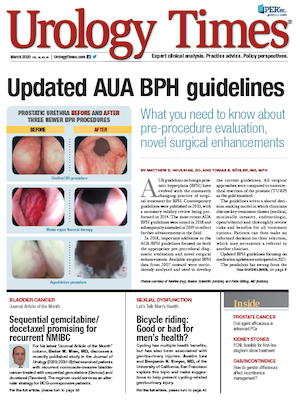Publication
Article
Urology Times Journal
Prednisone may improve total motile count post vasectomy reversal
Author(s):
A course of treatment with prednisone may offer improvement in mean total motile count for men who undergo vasectomy reversal and subsequently have partial or complete anastomotic obstruction, according to a recent study.
A course of treatment with prednisone may offer improvement in mean total motile count (TMC) for men who undergo vasectomy reversal and subsequently have partial or complete anastomotic obstruction, according to a recent study.
“We wanted to get this study together as the use of prednisone after vasectomy reversal is not uncommon, but the data supporting its use is extremely limited,” G. Luke Machen, MD, told Urology Times. Working with Johnathan Doolittle, MD, and Jay Sandlow, MD, he presented results from a retrospective study at the 2019 AUA annual meeting in Chicago.
Also see: PAE safe, durable for retention, hematuria in non-index BPH patients
Partial or complete anastomotic obstruction following vasectomy reversal can cause impaired semen parameters, and the authors hypothesized that corticosteroids may be able to reverse early scarring and inflammation involved in the obstruction. They conducted a retrospective review of patients treated between 2008 and 2018; of 368 total vasectomy reversals, they included 89 patients who had received prednisone. The regimen consisted of 2 weeks of prednisone, 20 mg daily followed by 2 weeks of 10 mg daily.
Of the 89 patients, 46 patients underwent a vasovasostomy (VV), 22 underwent a vasoepididymostomy (VE), and 21 underwent a VV/VE. The mean obstructive interval in the full cohort was 7.8 years, and prednisone was started an average of 5.54 months after the vasectomy reversal operation.
Next: Significant improvement in mean TMC seenSignificant improvement in mean TMC seen
The prednisone treatment was associated with a significant improvement in mean TMC. In the full cohort, the mean TMC before prednisone treatment was 3.7 million, compared with 14.2 million after the therapy, for a change of 10.5 million (p=.0002).
Read: Low-fat diet linked with lower testosterone level
Among the 46 patients who underwent a VV, the mean TMC rose from 6.5 million before prednisone to 19.9 million following the therapy, for an increase of 13.4 million (p=.0012). Among those who underwent a VE procedure, the mean TMC rose from 0.2 million to 8.6 million, for an increase of 8.4 million (p=.2). In those who underwent a VV/VE operation, the mean TMC increased from 1.2 million before prednisone to 7.4 million afterward, for a rise of 6.2 million (p=.014).
There were 24 patients who were azoospermic at the time of prednisone initiation. Of those, 33.3% saw an improvement in TMC. Among the 65 patients who were not, 76.9% saw an improvement in TMC (p=.0003).
“While not necessarily surprising, I think it’s notable that eight of 24 patients who were azoospermic at the time of initiating prednisone regained sperm in their ejaculate,” said Dr. Machen, a urologist in group practice in Austin, TX.
“This is an especially challenging patient cohort, and if prednisone leads to the return of sperm to the ejaculate, it could save the patient from another operation,” added Dr. Machen, who was a reproductive urology and andrology fellow at the Medical College of Wisconsin, Milwaukee at the time of the study.
The authors noted that it is possible the improvement in semen parameters would have occurred even without the prednisone treatment.
“Based on our results, it seems reasonable to consider a course of prednisone in select patients with suspected partial or complete anastomotic obstruction. However, I would not go so far as to say prednisone should be routinely used post operatively after vasectomy reversal. More well-designed trials are necessary to conclusively determine if the semen parameter improvements seen were the result of the prednisone or simply the result of more time post operatively,” Dr. Machen said.

Newsletter
Stay current with the latest urology news and practice-changing insights — sign up now for the essential updates every urologist needs.
























